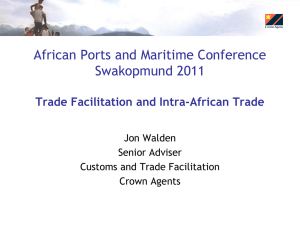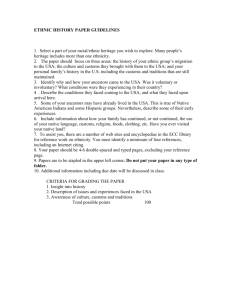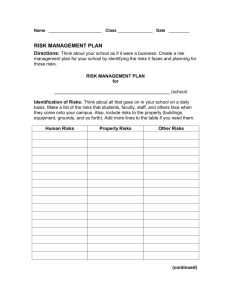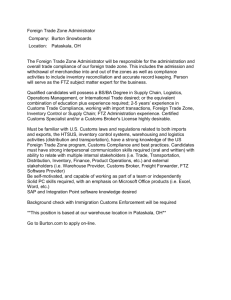Transport and Trade Linkages: Central Asia & Eastern Europe
advertisement
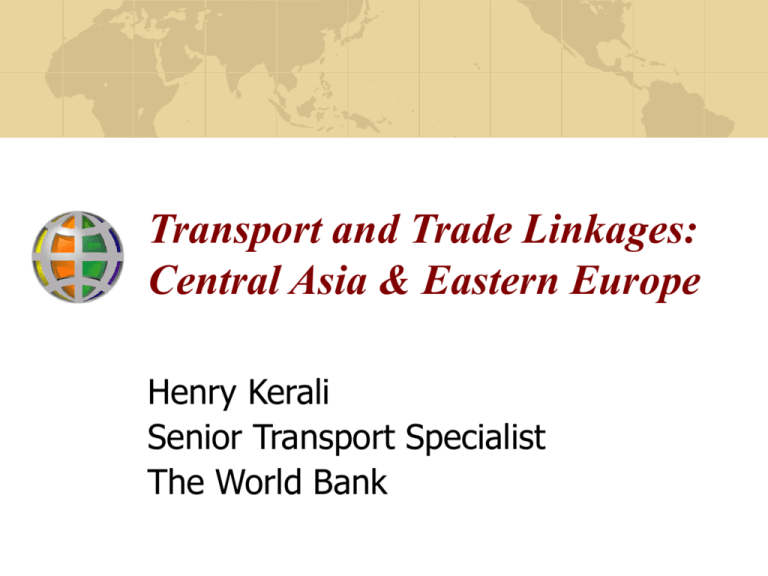
Transport and Trade Linkages: Central Asia & Eastern Europe Henry Kerali Senior Transport Specialist The World Bank Presentation Outline Central Asia Transport & Trade Status review Main trade corridors & linkages Trade & transport trends Impediments & suggested reforms Transport & Trade Facilitation in Southeast Europe (TTFSE) Current issues, project objectives & key actions Project components & achievements Recommendations & Scaling-up Exports from Central Asia To: From: Russia – Asia / Europe Europe – Asia – West and Southeast South and Fareast North America China Kazakhstan 44,822,516 8,211,831 574,525 14,191,597 4,113,412 Kyrgyzstan 111,648 7,006 877 530 90,675 Not specified; total export figure is: 736,119 Tajikistan Turkmenistan Uzbekistan 12,309 123,062 4,207 5,214 27,470 845,247 532,729 83,882 27,316 46,227 Source: TRACECA (Tons/Year) 2001 Imports to Central Asia From: To: Kazakhstan Kyrgyzstan Tajikistan Turkmenistan Uzbekistan Russia – Asia / Europe Europe – Asia – West and Southeast South and Fareast 9,848,318 251,825 North America 290,906 74,756 280,874 20,666 6,312 111,338 Not specified, total import figure is: 766,180 235,633 68 5,209 0 563,866 137,623 71,967 152,217 Source: TRACECA (Tons/Year) 2001 China 262,702 61,913 8,000 84,205 Main International Corridors Southern linkages for Central Asia Central Asia Corridor Performance Corridors North – Russia (Almaty-Moscow) West – Caucasus (Almaty – Baku) South – Iran (Almaty – Tehran) East – China (Almaty – Urumqi) Corridors North – Russia (Almaty-Moscow) West – Caucasus (Almaty – Baku) South – Iran (Almaty – Tehran) East – China (Almaty – Urumqi) Km 4,050 3,934 3,250 1,338 Rail Days 17 18 16 8 km/$ 3.7 2.2 2.7 1.3 Rail $/km km/day 0.26 238.2 0.46 218.5 0.37 203.1 0.76 167.3 USD 1,100 1,800 1,200 1,016 Km 4,391 4,090 3,120 1,330 Road Days 10 13 16 5 km/$ 1.3 0.8 0.7 0.5 Road $/km km/day 0.76 439.1 1.30 314.6 1.49 195.0 1.90 226.0 USD 3,350 5,300 4,650 2,150 Impediments to Trade & Transport High transportation and handling costs Poor transport infrastructure and transport performance Trade barriers of neighbouring countries Long and costly customs procedures and other inspections Lack of coordination between countries in the region Impediments amount to between 10 – 15% for roads and 2 – 10% for rail Transportation costs amount up to 50% Suggested Reforms Need for regional trade and transport policy Diversification of the transport industry including forwarding, handling, containerization, etc Regional harmonization and implementation of customs procedures Promotion of trade and transport standards Common and transparent transit fees Development of rail shuttle services Implementation of international freight handling standards, e.g. TIR, ASYCUDA, etc. Trade and Transport Facilitation in Southeast Europe (TTFSE) World Bank supported project The Issues The high cost and uncertainties of trade and transport in Southeast Europe are major constraints on economic recovery and development in the region Complicated, opaque and non-standardized border procedures affect the business environment and deter foreign investment (the Paper Curtain) Countries concerned with high level of corruption, smuggling, organized crime Customs administrations do not have aligned legislation and procedures with EU standards Project Objectives Reduce non-tariff costs to trade and transport Reduce smuggling and corruption at border crossings Actions (1) Getting donors on board to complement / coordinate / provide assistance Regional approach/mechanisms: Regional Forum: Steering Committee Public – Private Partnerships (PPP) Training programs for transport operators, freight-forwarders, importers, exporters TTFSE website Survey of users Actions (2) Focus on Customs procedural reforms Border Inter-agency awareness and cooperation Pilot approach: 27 selected border crossing points and in-land stations National Coordinator Performance monitoring: overall Customs and pilot indicators Local Project Teams Country & Regional Program Regional Investment Program: US$120 m WB $78 million US Government (grant) $13 million; Others: France, Austria Each project was designed to be country specific, but supported the development objectives by the selection of elements under similar components Common Components Supporting customs reform Strengthening mechanisms of interaction and cooperation between private and public parties at regional, national, and local levels Disseminating information and providing training to the private sector Achievements in 2 ½ years … Significant reduction of waiting time at the border and inland pilot points (50% and more) leading to US$8million savings annually Improved dialogue among Customs administrations through regional consultation and information sharing (8 RSC meetings) “Institutional awareness”: the facilitation role of border agencies vs. revenue collection & control classic roles Transparent and public Customs performance monitoring system in place Achievements in 2 ½ years .. User participation in the evaluation of border agencies’ performance A collaborative culture of partnership between the public and the private sectors Certified learning opportunities in road transport operations (85 locations and online) Detailed information available to the public at: www.TTFSE.org Achievements in 2 ½ years. Revenue collected by Customs doubled through risk management and selectivity approach Higher than estimated trade volumes increase (e.g almost doubled in Romania) EC – WB Policy Notes from lessons learned Scaling-up TTF REPLICATE the program to other/all borders, and cross-border projects in SEE EXPAND the approach and methods to railways, inland water-ways, ports, airports STREAMLINE international transport documentation & linkages REPLICATE the program to other regions, e.g. Caucasus, Central Asia, South Asia, East Asia, etc.
